Pallett, Charles Gordon
Prisoner of War 1944-06-15


Birth Date: 1923-April-11
Born:
Home: Toronto, Ontario
Enlistment: Toronto, Ontario
Enlistment Date: 1941-11-10
Service
RCAF
Unit
424 (B) Sqn- Squadron
Castigandos Castigamus Chastise those deserving
Base
RAF Skipton-on-Swale
Rank
Flying Officer
Position
Warrant Officer 2nd Class
Service Numbers
J/89288
Prev: R/141179
PoW: 616
Home
Target
Flying Officer Pallett evaded for a time with the help of French locals and resistance fighters until he was caught and captured 1944-08-09. Originally sent to a civilian prison at St Quentin, France, Pallett was eventually sent to Stalag Luft 7 and was one of 1,500 force-marched out of the camp 1945-01-19 as Russian forces advanced, arriving at Stalag 3A on 1945-02-08. The camp guards fled less than two weeks later as the Russian advance continued, leaving all Allied Prisoners of War behind. Russian troops turned the camp over to American forces and Flying Officer Pallett was evacuated safely, back to the UK 1945-05-14
Footprints on the Sands of Time, RAF Bomber Command Prisoners of War in Germany 1939-45 by Oliver Clutton-Brock, page 376
The Long Road, Trials and Tribulations of Airmen Prisoners from Stalag Luft VII (Bankau) to Berlin, June 1944-May 1945 by Oliver Clutton-Brock and Raymond Crompton, page 328
Halifax B.Mk.III LW121
Bombing Cambrai France 1944-June-14 to 1944-June-15
424 (B) Sqn (RCAF) RAF Skipton-on-Swale
424 Tiger Squadron (Castigandos castigamus) RAF Skipton-on-Swale. Halifax III aircraft LW 121 QB-X was shot down by night fighter pilot Uffz Kurt Leitner of 2/NJG4 during an operation to bomb rail facilities at Cambrai, France in support of the D-Day landings.The Halifax was abandoned by the crew at 11,000 feet and crashed near Cambrai.
Warrant Officer Class 1 George Alexander Edwin Compton (RCAF), Flight Lieutenant Peter Cameron Hamilton (RCAF), Pilot Officer Calvin Becker Cornelius (RCAF), Flying Officer Charles Gordon Pallett (RCAF) and Sergeant Walter Lawrence Cousins (RAFVR) all survived to become Prisoners of War
Flying Officer Donald Robert McCormick (RCAF) and Warrant Officer 2nd Class Robert Charles McCubbin (RCAF) both survived and avoided capture as Evaders
![]() Royal Air Force Serial and Image Database
Royal Air Force Serial and Image Database
![]() 14/15 06 1944 424 (Tiger) Squadron RCAF Halifax III LW 121 Flt Lt Peter C....
14/15 06 1944 424 (Tiger) Squadron RCAF Halifax III LW 121 Flt Lt Peter C....
330 aircraft - 61 Lancasters, 255 Halifaxes, 14 Mosquitoes - of 4, 6 and 8 Groups attacked railways al Cambrai, Douai and St-Pol. All of the targets were either partially cloud-covered or affected by haze and the bombing was not completely concentrated or accurate. 3 Halifaxes and 1 Lancaster were lost, the Lancaster being the Master Bomber's aircraft at Douai.
source: The Bomber Command War Diaries, Martin Middlebrook and Chris Everitt
Failed to return from attack on the rail yards at St. Pol and Cambrai, shot down by a night fighter, 15 June 1944. 2 killed 5 POW.
Handley Page Halifax

The Handley Page Halifax is a British Royal Air Force (RAF) four-engined heavy bomber of the Second World War. It was developed by Handley Page to the same specification as the contemporary twin-engine Avro Manchester.
The Halifax has its origins in the twin-engine HP56 proposal of the late 1930s, produced in response to the British Air Ministry's Specification P.13/36 for a capable medium bomber for "world-wide use." The HP56 was ordered as a backup to the Avro 679, both aircraft being designed to use the underperforming Rolls-Royce Vulture engine. The Handley Page design was altered at the Ministry to a four-engine arrangement powered by the Rolls-Royce Merlin engine; the rival Avro 679 was produced as the twin-engine Avro Manchester which, while regarded as unsuccessful mainly due to the Vulture engine, was a direct predecessor of the famed Avro Lancaster. Both the Lancaster and the Halifax would emerge as capable four-engined strategic bombers, thousands of which would be built and operated by the RAF and several other services during the War.
On 25 October 1939, the Halifax performed its maiden flight, and it entered service with the RAF on 13 November 1940. It quickly became a major component of Bomber Command, performing routine strategic bombing missions against the Axis Powers, many of them at night. Arthur Harris, the Air Officer Commanding-in-Chief of Bomber Command, described the Halifax as inferior to the rival Lancaster (in part due to its smaller payload) though this opinion was not shared by many of the crews that flew it, particularly for the MkIII variant. Nevertheless, production of the Halifax continued until April 1945. During their service with Bomber Command, Halifaxes flew a total of 82,773 operations and dropped 224,207 tons of bombs, while 1,833 aircraft were lost. The Halifax was also flown in large numbers by other Allied and Commonwealth nations, such as the Royal Canadian Air Force (RCAF), Royal Australian Air Force (RAAF), Free French Air Force and Polish forces.Wikipedia
![]() National Air Force Museum of Canada
National Air Force Museum of Canada
424 (B) Sqn Castigandos Castigamus ("Tiger")
History of the Squadron during World War II (Aircraft: Wellington III, X, Halifax III, Lancaster I, III)
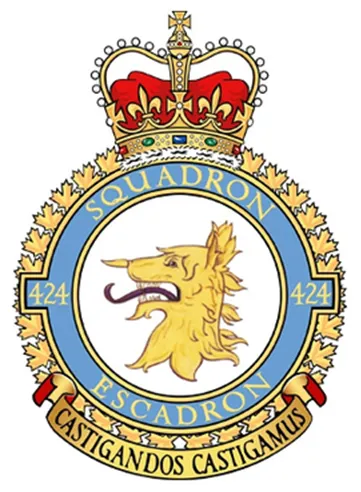
424 Squadron was the sixth RCAF bomber squadron to be formed overseas in WWII, at Topcliffe, Yorkshire, UK ![]() on October 15, 1942, originally as part of No 4 Group of RAF Bomber Command. It remained at Topcliffe when it was transferred to the newly-formed 6 (RCAF) Group on January 1, 1943. It moved to Leeming, Yorkshire
on October 15, 1942, originally as part of No 4 Group of RAF Bomber Command. It remained at Topcliffe when it was transferred to the newly-formed 6 (RCAF) Group on January 1, 1943. It moved to Leeming, Yorkshire ![]() , and then Dalton, Yorkshire
, and then Dalton, Yorkshire ![]() , flying Vickers Wellington Mk III and X aircraft before being dispatched on June 22, 1943 to No 331 (RCAF) Wing of No 205 Group in Tunisia (Kairouan/Zina
, flying Vickers Wellington Mk III and X aircraft before being dispatched on June 22, 1943 to No 331 (RCAF) Wing of No 205 Group in Tunisia (Kairouan/Zina ![]() and Hani East
and Hani East ![]() airfields), from where it flew in support of the invasions of Sicily and Italy. It returned by sea to Skipton-on-Swale, Yorkshire
airfields), from where it flew in support of the invasions of Sicily and Italy. It returned by sea to Skipton-on-Swale, Yorkshire ![]() in October/November 1943. It re-equipped with Handley Page Halifax Mk III aircraft, which it flew until January 1945, when it re-equipped with Avro Lancaster I and III aircraft. After the termination of hostilities in Europe, the squadron was transferred to No 1 Group, and was employed in operation DODGE, the repatriation of British and Canadian troops from Italy. It was disbanded at Skipton on October 15, 1945, 3 years to the day since its formation.
in October/November 1943. It re-equipped with Handley Page Halifax Mk III aircraft, which it flew until January 1945, when it re-equipped with Avro Lancaster I and III aircraft. After the termination of hostilities in Europe, the squadron was transferred to No 1 Group, and was employed in operation DODGE, the repatriation of British and Canadian troops from Italy. It was disbanded at Skipton on October 15, 1945, 3 years to the day since its formation.
In the course of hostilities, the squadron flew 3257 sorties for the loss of 52 aircraft. 8776 tons of bombs were dropped. Crew members were awarded 1 DSO, 49 DFC's and 1 Bar to DFC, 1 CGM, 11 DFM's and 1 MiD. Battle Honours were: English Channel and North Sea 1943-45, Baltic 1944-45, Fortress Europe 1943-44, France and Germany 1944-45, Biscay Ports 1943-44, Ruhr 1943-45, Berlin 1944, German Ports 1943-45, Nornamdy 1944, Rhine, Bisacy 1943-44, Sicily 1943, Italy 1943, Salerno.Wikipedia, Kostenuk and Griffin
Squadron History (Bomber Command Museum PDF)
Maps for Movements of 424 Squadron 1942-45
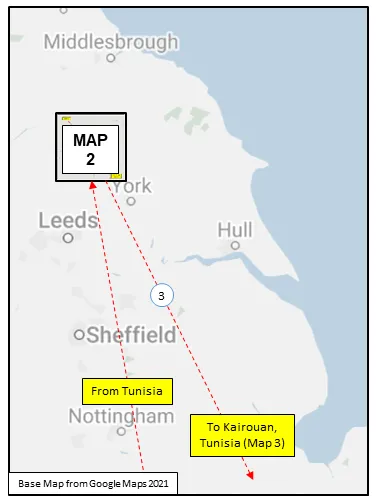 MAP 1: 424 Squadron Movements 1942-45 (right-click on image to display enlarged in new tab) | 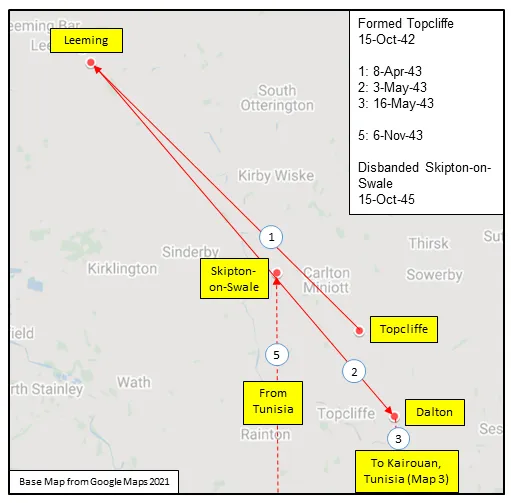 MAP 2: 424 Squadron Movements 1942-45 (detail of Map 1) | 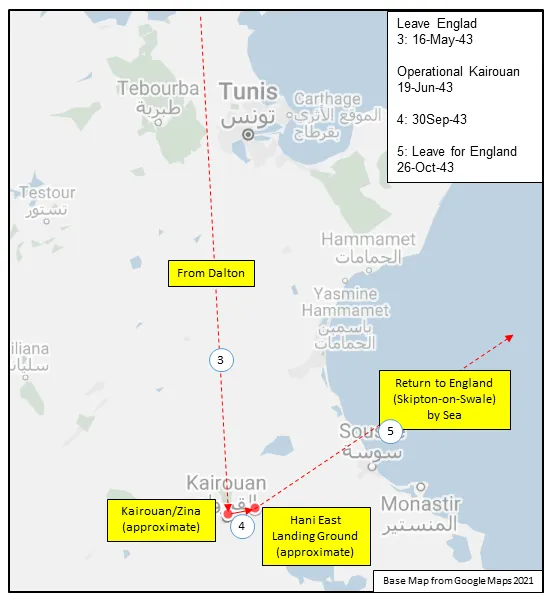 MAP 3: 424 Squadron Movements in North Africa 1943 |
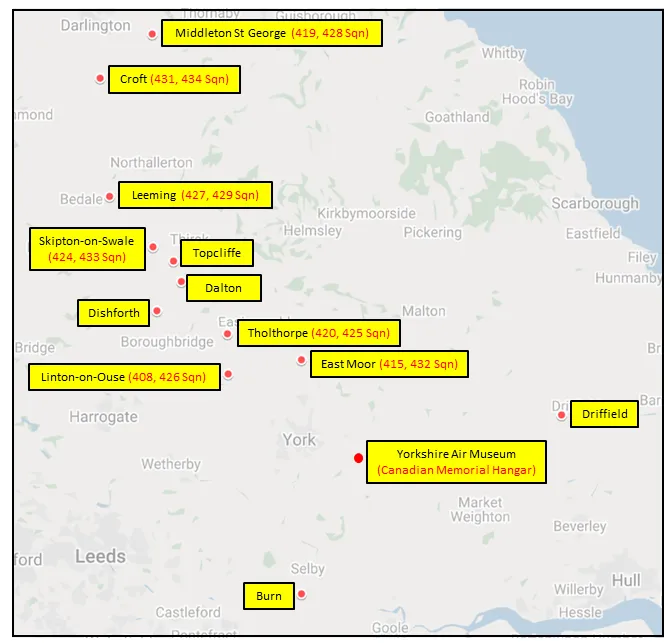
424 Squadron History Summary 1942-45
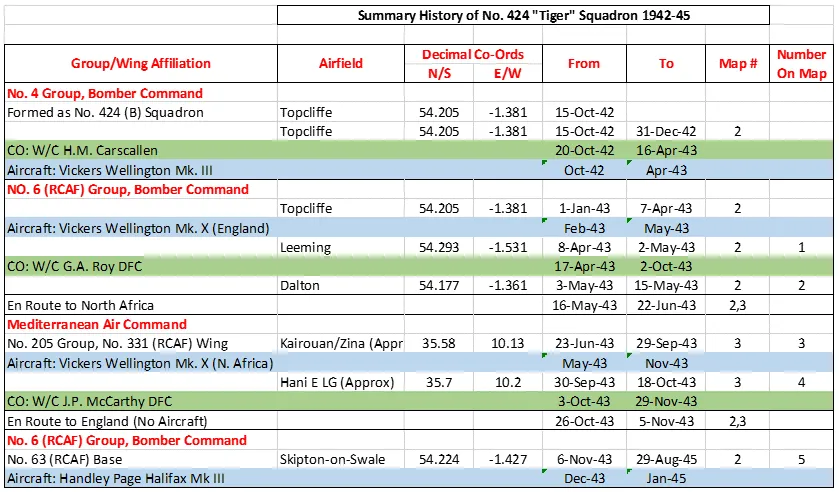
424 Squadron History Summary 1942-45 Page 2

History of the Squadron Post-WWII (Aircraft: Harvard II, Mustang IV, Silver Star 3, Expeditor, Otter, Griffon, Hercules)
The squadron was re-formed at Mount Hope, Hamilton, Ontario ![]() on 15 April 1946, as a light bomber unit. It was redesignated as an auxiliary fighter unit on 1 April 1947. It flew North American Harvard II and Mustang IV aircraft in a fighter role, as well as Canadair Silver Star aircraft until 1 September 1957 when it was then reassigned as a light transport and emergency rescue role and re-equipped with Beechcraft Expeditor and de Havilland Otter aircraft. On 21 October 1961 the unit received its Squadron Standard for 25 years’ service as No. 119 and 424 Squadron. A reduction of the Auxiliary Force resulted in the squadron being disbanded on 1 April 1964. On 8 July 1968, with unification of the Canadian Forces, the squadron was reactivated as 424 Communications and Transport Squadron, operating from CFB Trenton, Ontario
on 15 April 1946, as a light bomber unit. It was redesignated as an auxiliary fighter unit on 1 April 1947. It flew North American Harvard II and Mustang IV aircraft in a fighter role, as well as Canadair Silver Star aircraft until 1 September 1957 when it was then reassigned as a light transport and emergency rescue role and re-equipped with Beechcraft Expeditor and de Havilland Otter aircraft. On 21 October 1961 the unit received its Squadron Standard for 25 years’ service as No. 119 and 424 Squadron. A reduction of the Auxiliary Force resulted in the squadron being disbanded on 1 April 1964. On 8 July 1968, with unification of the Canadian Forces, the squadron was reactivated as 424 Communications and Transport Squadron, operating from CFB Trenton, Ontario ![]() . The squadron has flown more than 14 different types of aircraft during its history.
. The squadron has flown more than 14 different types of aircraft during its history.
424 (Tiger) Squadron is now a Transport and Rescue Squadron based at 8 Wing Trenton. To fulfil its roles, 424 Squadron operates the CH-146 Griffon helicopter and the CC-130H Hercules. 424 Squadron and 435 Transport and Rescue Squadron provide primary search and rescue response for the Trenton Search and Rescue Region (SRR), the largest in Canada. The Trenton SRR extends from Quebec to the British Columbia/Alberta border, and from the Canada/United States border to the North Pole. The Squadron crews one aircraft of each type on standby response posture in order to respond to distress cases as tasked by Joint Rescue Coordination Centre Trenton.
In addition to providing SAR response through a para-rescue capability, the CC-130H Hercules allows the squadron to conduct its transport role in Canada and around the world. The CH-146 Griffon enables rescues and medical evacuations from locations on land and over water. Both aircraft carry Search and Rescue Technicians onboard in order to provide urgent care to those in need. The members of 424 Squadron provide SAR response to incidents under the federal SAR mandate; all aircraft incidents and all marine incidents in waters under federal jurisdiction. They also support humanitarian missions and other SAR organizations when able. Wikipedia and www.canada.ca/en/air-force/corporate/squadrons/424-squadron.html
 Library and Archives Canada Service Files (may not exist)
Library and Archives Canada Service Files (may not exist)
